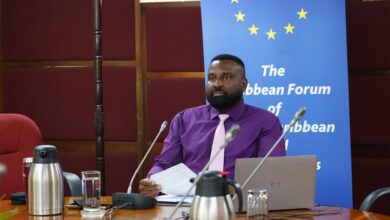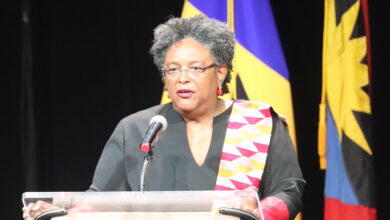The CARICOM Secretariat’s pilot project with High School teachers in Belize and Guyana teaching each other’s classes online finished today. Mr. Albert Inshanally of Queen’s College Guyana taught the class of Ms. Stefphoney Grinage of Sacred Heart College in Belize. Approximately 70 students participated in the merged classes with a lesson focusing on Regional Integration and the CSME. Mr. Inshanally explained how CARICOM fosters a critical mass allowing for the creation of different opportunities, delved into the CSME and gave an appreciation of why CARICOM is needed.
The pilot started on 10 May 2021 and in his closing remarks the Programme Manager, CARICOM Single Market, Mr. Titus Preville complimented the teachers, students and others who assisted in ensuring a successful activity. The project is part of the CARICOM Secretariat’s continued public education programme on the CSME.

Remarks by Mr. Titus Preville
Programme Manager, CARICOM Single Market
Final Lesson of Pilot – Teaching Regional Integration and the CSME in CARICOM Classrooms.
Thursday, 20 May 2021, 11:40 A.M

Representatives from the Ministries responsible for Education and Trade in Belize and Guyana; teachers and students from the classes at Queen’s College in Guyana and Sacred Heart College in Belize; my colleagues from the CARICOM Secretariat, a good morning to you all. It is now 9.40 am in Belize and 11.40 am here in Barbados and Guyana.

I bring greetings from the Caribbean Community Secretariat, as we are about to begin the final lesson in this pilot activity, in which Mr. Albert Inshanally of Queen’s College in Guyana will be teaching the class of Ms. Stefphoney Grinage of Sacred Heart College in Belize. Today’s session is the second lesson on being One differently, focusing on how CARICOM fosters a critical mass which allows for the creation of different opportunities. It will also delve a little deeper on the CSME and give an appreciation of why we need CARICOM.

Let me pause here and help us reflect on the journey you teachers and students started two weeks ago when Ms. Eletha Stewart-Johnson of Queen’s College in Guyana started the first lesson on Monday 10 May, teaching the class of Mr. Abdiel Medina of the Ladyville Technical High School in Belize. Mr. Medina taught Ms. Stewart-Johnson’s class on Monday this week and we had Ms. Stefphoney Grinage teaching Mr. Inshanally’s class last Thursday and now we wrap up with the final lesson today.
I pause and say thanks to all of you – teachers and students. Thanks to the Ministries of Education and Trade in Belize and Guyana; the Principals and Presidents of the schools; the parents; the CSME Focal Points and our own colleagues within the CARICOM Secretariat. Special mention of Dr. Laurette Bristol our Programme Manager, Human Resource Development and her team in the Directorate of Human and Social Development who collaborated so well with Mr. Salas Hamilton, the Specialist Communications in the CSME Unit who has led the charge over the years in guiding our public education programmes on the CSME.

I share my own personal view that this work must not stop. Already we in the CARICOM Secretariat are discussing ways we may be able to continue these virtual activities even within our limited capacity. It is my understanding that the four teachers who participated in this CARICOM Secretariat pilot were so enthused that a camaraderie has developed among them. A camaraderie of support and appreciation for what they taught, and the pairing of teachers may have assisted in developing that relationship, which I sincerely hope will continue after today. Think of it, High School teachers and students from Belize and Guyana coming together to share a CARICOM experience albeit a virtual one.
I also believe that the youth of today, not just High School students, but starting from kindergarten must be the focus of our messaging on regional integration and the CSME. That is how we will develop a CARICOM psyche to stem the brain drain from this region and to see our economic space as a main option for sustainable livelihoods, notwithstanding our challenges. The truth is, everywhere has challenges. So our focus must be on making best use of what is possible as opposed to dwelling on our constraints.

We hope the objective of this pilot was achieved, which as Dr. Bristol said in her remarks two weeks ago, is to further enhance the implementation of the CSME by bringing elements of CARICOM even more integrally into our classrooms. You teachers have made significant efforts in researching some complex issues and making them digestible for students. The use of the technology certainly assists, as we noted the use of graphics, avatars, music, power point presentations and who knows what Mr. Inshanally will be using today to enhance his lesson. All teachers thus far also shared a bit of their culture and highlights of their country.
You would know of the original project, which was scheduled to start last year, but it is delayed because of the pandemic. It is a series of planned high school teacher exchanges across CARICOM for two weeks at a time, traveling and participating in each other’s classrooms. That original project is supported by the European Union and we hope it can start as soon as borders are opened, and physical in-class teaching starts across the region.
The sessions over these last two weeks have caused a ripple within the news media across the region and as recent as yesterday, a media house interviewed us on the project. The main question was when other CARICOM Member States will be able to participate. Well I answered that earlier and repeat that efforts will be made to follow up. Of course, we are cognizant of school schedules, exams and teacher workloads, so we would have to also engage Ministries of Education too. Our vision is for the Ministries of Education throughout CARICOM to consider what has happened here under this pilot project. They can then begin a process that will result in the teaching of CARICOM integration and even Caribbean History becoming shared experiences by the teachers and students of the Caribbean Community.
Thanks everyone. I invite all of you who are on Instagram to also visit us at csmeonline and like any posts you see, especially of this activity. I hand over to Mr. Inshanally of Queen’s College in Guyana. Best wishes for today’s lesson.






